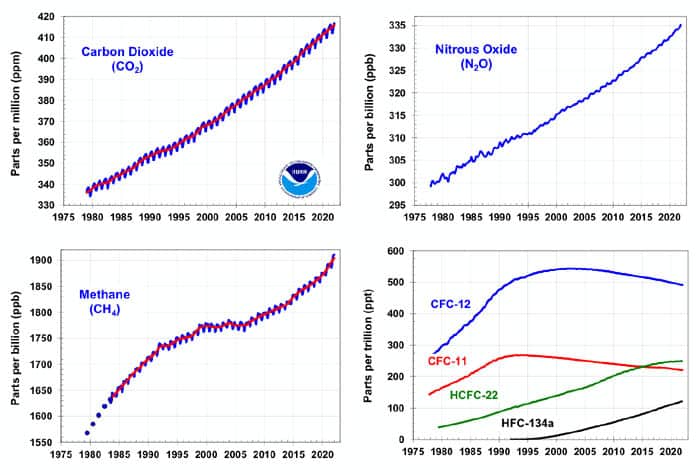
This graph depicts the relative contributions of the major greenhouse gas pollutants to global warming, in watts per square meter along the left axis. The NOAA Annual Greenhouse Gas Index (AGGI) is shown on the right axis. (NOAA Global Monitoring Laboratory)
Greenhouse gas pollution caused by human activities trapped 49% more heat in the atmosphere in 2021 than they did in 1990, according to scientists at the US National Oceanic and Atmospheric Administration.
NOAA’s Annual Greenhouse Gas Index (AGGI), tracks increases in the warming influence of human emissions of heat-trapping gases, including carbon dioxide, methane, nitrous oxide, chlorofluorocarbons, and 16 other chemicals. It is indexed to 1990, the baseline year for the Kyoto Protocol and the year the first IPCC Scientific Assessment of Climate Change was published.
“Our measurements show the primary gases responsible for climate change continue rising rapidly, even as the damage caused by climate change becomes more and more clear,” says Ariel Stein, the acting director of NOAA’s Global Monitoring Laboratory. “The scientific conclusion that humans are responsible for their increase is irrefutable.”
In 2021, the AGGI reached a value of 1.49, which means that human-emitted greenhouse gases trapped 49% more heat in the atmosphere than in 1990. Because it is based primarily on highly accurate measurements of greenhouse gases in air samples collected around the globe, the result contains little uncertainty.

Global average abundances of the major, well-mixed, long-lived greenhouse gases – carbon dioxide, methane, nitrous oxide, CFC-12 and CFC-11 – and 15 other halogenated gases. (NOAA Global Monitoring Laboratory)
NOAA measurements show the global average concentration of CO2 in 2021 was 414.7 parts per million (ppm). The annual increase was 2.6 ppm during this year, about the average annual increase for the previous decade, and much higher than the increase measured during 2000-2009. CO2 levels have risen by 61 ppm since 1990, accounting for 80% of the increased heat tracked by the AGGI since that year.
CO2 stays in the atmosphere and oceans for thousands of years and it is by far the largest contributor to global warming. Eliminating CO2 pollution has to be front and center in any efforts to deal with climate change.
One of the most important scientific questions for climate scientists is what’s been driving the sharp, sustained increase of the second-most important greenhouse gas — methane — since 2006. Levels of atmospheric methane averaged 1,895.7 parts per billion during 2021. The increase recorded for 2021 was the fastest observed since the early 1980s, when a more rigorous measurement regime was initiated. Methane levels are currently around 162% greater than pre-industrial levels. The amount of methane emitted in 2021 was 15% greater than the 1984-2006 period.
The third-most important greenhouse gas is nitrous oxide, a long-lived climate forcing pollutant produced by fertilizer use in agriculture.
These three greenhouse gases, plus two banned ozone-depleting chemicals, account for about 96% of the excess heat trapped in the atmosphere due to human activity since 1750. The remaining 4% is from 16 other greenhouse gases also tracked by the AGGI. In aggregate, they trapped an amount of heat equivalent to 508 ppm of CO2 in 2021.
(Adapted from materials provided by NOAA.)



Very graphic representation of the terrible situation that capitalism has place humanity in. One thing to note is that the radiative forcing term used here is a relative value, not the total heating effect due to greenhouse gases, but the excess in comparison to the pre-industrial period (1750 CE) which is given the value zero. The AGGI is defined as being zero in 1750 as well.
The chances of getting back to the GHG concentrations of 1750 are negligible. If GHG concentrations are stabilised at the current level, then warming will still occur for many decades, as the seas absorb the extra heat due to this forcing and come into equilibrium with the atmosphere.
You can calculate what equilibrium temperature rise current CO2eq concentration corresponds to – it is a logarithmic relationship. (For those interested, for a climate sensitivity of 3degC for every doubling of CO2eq, I reckon the formula comes out to deltaT=4.328*ln(CO2eq) – 24.388). If the value in the article of a current CO2eq of 508ppm is correct, then that corresponds to a warming of 2.6degC. An equilibrium value 1.5degC warming corresponds to a CO2eq of 395ppm, so over 20% of the earth’s CO2 (eq) needs to be removed from the atmosphere – 650-700 billion tonnes if it is all CO2. That is a big ask, even if it has all been put there since the Kyoto Protocol was agreed.